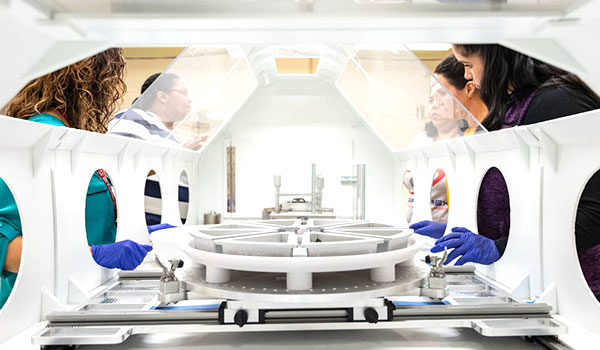NASA’s OSIRIS-REx spacecraft is returning to Earth with a sample collected from asteroid Bennu’s rocky surface. It marks the United States’ first-ever mission to return an asteroid sample to Earth, and scientists worldwide will analyze the unique material dating from the early formation of our solar system. The mission has taken over 12 years to culminate in the return of the samples, estimated to hold about a cup of Bennu’s material. The spacecraft will release the sample return capsule on September 24, 2023, estimated to land within a targeted area in the Utah Test and Training Range and Dugway Proving Grounds. Recovery crews will secure the landing site and collect soil and air samples to identify any minute contaminants that may have contacted the asteroid sample. The mission’s success will provide valuable insights into asteroids’ composition and may pave the way for future space exploration endeavors.
NASA’s OSIRIS-REx to Deliver First-Ever Asteroid Sample to Earth
NASA’s OSIRIS-REx spacecraft is on its way back to Earth, carrying a sample it collected from asteroid Bennu’s rocky surface. The sample is set to parachute down into Utah’s desert on September 24, 2023, marking the United States’ first mission to return an asteroid sample to Earth.
The mission is a testament to the spacecraft’s seven-year journey, including a dramatic touchdown on Bennu to gather dust and rocks. However, it now faces one of its biggest challenges: delivering the asteroid sample to Earth while keeping it safe from heat, vibrations, and earthly contaminants.
NASA’s Goddard Space Flight Center’s deputy project manager, Mike Moreau, emphasized the urgency of the recovery process upon the sample capsule’s touchdown. The team will need to race against the clock to recover it and transport it to a temporary clean room.
For the next six months, the OSIRIS-REx team will practice and refine procedures to recover the sample in Utah and transport it to a new lab built for the material at NASA’s Johnson Space Center in Houston.
Once the sample is unpacked, up to 25% of it will be distributed to the OSIRIS-REx science team worldwide for analysis, while the remainder will be curated for future generations of scientists.
Flight dynamics engineers at NASA Goddard and KinetX Aerospace are reviewing the spacecraft’s trajectory to bring it close to Earth, while Lockheed Martin in Denver is preparing a group to recover the sample capsule. Crews in Colorado and Utah will practice all the steps to recover the capsule safely, while protecting it from contamination.
Meanwhile, members of the sample science team are preparing for investigations they will perform once they receive the sample material. Dante Lauretta, OSIRIS-REx principal investigator from the University of Arizona, Tucson, commended the team’s impressive work in characterizing and sampling asteroid Bennu.
In conclusion, the mission is an achievement that demonstrates the power of scientific inquiry and technology. Its successful completion will provide a wealth of knowledge about asteroids’ composition and may pave the way for future space exploration endeavors.
NASA’s OSIRIS-REx Mission to Deliver Pristine Asteroid Sample
NASA’s OSIRIS-REx mission aims to deliver a pristine sample from asteroid Bennu that is free from terrestrial contaminants. Asteroids are believed to contain molecular precursors to life and may have played a role in delivering compounds to Earth’s surface over 4 billion years ago. Scientists need a pristine sample to understand the development of the solar system fully.
On September 24, as the OSIRIS-REx spacecraft flies by Earth, it will release its sample return capsule, estimated to hold about a cup of Bennu’s material – 8.8 ounces +/- 3.6 ounces (250 grams +/- 101 grams) to be precise. The capsule will land within a 37-mile by 9-mile ellipse (59 km by 15 km) within Department of Defense property that is part of the Utah Test and Training Range and Dugway Proving Grounds, thereby ending the primary mission.
OSIRIS-REx’s team members have used computer models to test navigation plans in various weather, solar activity, and space debris scenarios to ensure the capsule touches down inside the targeted area 13 minutes after entering Earth’s atmosphere at 10:41 a.m. ET (8:41 a.m. MT).
Recovery crews will secure the sample return capsule’s landing site and collect soil and air samples from all around the landing capsule to identify minute contaminants that may have contacted the asteroid sample.
Once the capsule is inside the portable clean room building at the range, members of the team will remove the heat shield, back shell, and other components to prepare the sample canister for transport to Houston.
NASA’s OSIRIS-REx mission is a result of extensive training and rehearsals to bring discipline and dedication to the final phase of flight operations. The curation team at NASA’s Johnson Space Center in Houston will be the first to see and handle the sample OSIRIS-REx is returning from asteroid Bennu. The team has practiced with a mock glove box to ensure that the sample’s chemistry and mineralogy are not muddled by Earth’s pervasive water and biology.
The most fragile rocks observed on Bennu would not have survived passage through Earth’s atmosphere as meteorites, making the asteroid sample essential to understanding the development of the solar system. The mission’s successful completion will provide valuable insights into asteroids’ composition and may pave the way for future space exploration endeavors.
NASA’s Bennu Asteroid Sample Marks New Phase of Discovery
NASA’s more than 12-year mission with its partners will culminate in the return of samples from asteroid Bennu. The unique and precious material dating from the early formation of our solar system will undergo analysis by scientists worldwide, marking the beginning of a new phase of discovery.
Don’t miss interesting posts on Famousbio
